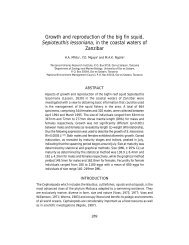gpa_east_africa_case.. - GRID Africa GeoPortal - UNEP
gpa_east_africa_case.. - GRID Africa GeoPortal - UNEP
gpa_east_africa_case.. - GRID Africa GeoPortal - UNEP
You also want an ePaper? Increase the reach of your titles
YUMPU automatically turns print PDFs into web optimized ePapers that Google loves.
Distribution of hospitals, health centres and dispensaries in DSM region, 1997Number of hospitalsVoluntaryFacilities Government agency Parastatal Private TotalHospitals 3 1 2 30 36Health centres 4 2 2 5 13Dispensaries 52 65 61 202 380Source: An Environmental Health Profile for DSM region by NEMC1998General Environmental Sector ProblemsUrbanization. Urbanisation is the most dynamic factor underlying most of the immediatecauses of environmental degradation. Rapid urban population growth imposes heavydemands on the already densely inhabited housing areas, most of which are unplanned andlack organised sanitary and wastewater infrastructure systems. Urban population growth inDSM is currently around 8% per year outpacing the limited capacities of municipal authoritiesto supply adequate infrastructure facilities. It is estimated that 70% of the population live inover 40 unplanned communities covering an area of 10,000 ha. Uncontrolled disposal ofwastewater and solid wastes is a common problem affecting water sources and livingconditions in all unplanned settlements, particularly in settlements such as Manzese andVingunguti. Outbreaks of water-borne diseases are frequent during the rainy seasons.Domestic wastewater. DSM has no operative sewage collection infrastructure. Thesewerage system is old and degenerated. It covers an area of 130km of sewer and consistsof 11 networks supported by 17 pumping stations, including the City Center, parts of Sinza,Ubungo and Vingunguti. It was built in the late 1950's and its attempted rehabilitated in theperiod 1980–1988 has been unsuccessful. Sewage from the areas supposed to be served isdischarged into oxidation ponds and directed to the ocean untreated. Poor managing of theseponds result in overflowing and spreading of sewer to the surroundings. Only 4 of the 8oxidation ponds are considered to be operating (University of Dar-es-Salaam, Kurasini,Mikocheni and Vingunguti). Only 15% of the households are connected to the system. 80% ofthe households in the rest of DSM use on-site pit latrines and septic tanks. High water table invarious parts of the city during the short and long rains further compounds the poor sanitaryconditions with many pits overflowing into the drainage system emptied manually, often by thefamilies themselves and occasionally by private companies at a cost.Industrial wastes. The rapid growth of informal sector activities, particularly workshops andrepair establishments, generate industrial wastes in settlement areas and near rivers adjacentto coastal areas. Industrial development and more so small and medium size workshops arenot subject to proper Environmental Impact Assessment due to institutional inadequaciesrelative to the sheer scale, pace of undetected nature of informal sector activities. Carwashing activities are often sited near streams (e.g. Msimbazi river along Jangwani, nearKilimanjaro Hotel etc) discharging dirty water covered with layers of oil. At the ports shipshandle large quantities of oil with frequent oil leakage from Tazama Pipeline. Oil spills alsooccur during operational transfer of oil from tankers into receiving facilities. Within the cityindustries are concentrated mainly in the Mikocheni light industrial area, Nyerere roadindustrial area, Changombe industrial area, Morogoro Road industrial area, Mandela expressindustrial area and Mbezi along Ali Hassan Mwinyi road. Many industries discharge untreatedeffluents directly or through storm water drainage, river creeks and streams or estuarydrainage into the sea.• Msimbazi river has been found to be heavily polluted due to effluents from industriesalong Nyerere road industrial area (e.g. Vingunguti abattoir), Morogoro road (e.g.Tanzania-China Friendship Textile mill), Mandela road (e.g. Tradeco Ltd), TanzaniaBreweries Ltd. Dar es Salaam plant, leachate from Vingutinguti crude dump.• Karibu Textile Mill discharges its effluent to the Mzinga River.• Leachate from closed Kabuma crude dump (in Temeke) flowed into the ocean (nowclosed ).The extent of industrial pollutants has not been quantified to provide further information.Final Draft Report – Cost Benefit Case StudiesGPA Strategic Action Plan on Sewage, October, 200081



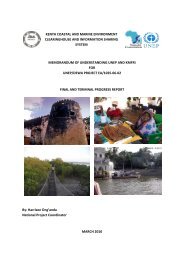
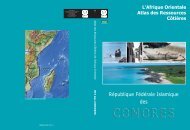
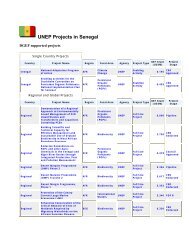

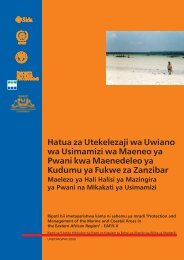
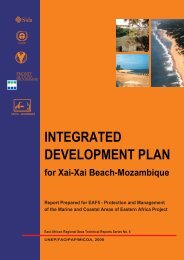
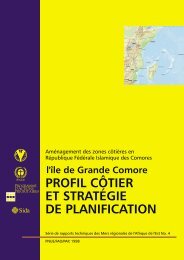
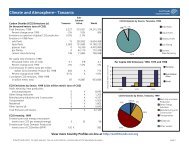

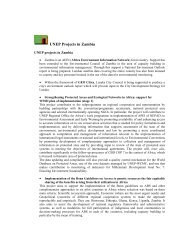
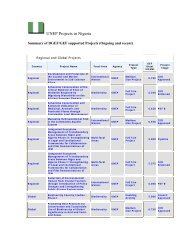
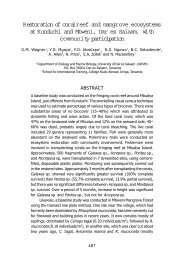
![Please Click to download [English] - GRID Africa GeoPortal - UNEP](https://img.yumpu.com/30633391/1/184x260/please-click-to-download-english-grid-africa-geoportal-unep.jpg?quality=85)
